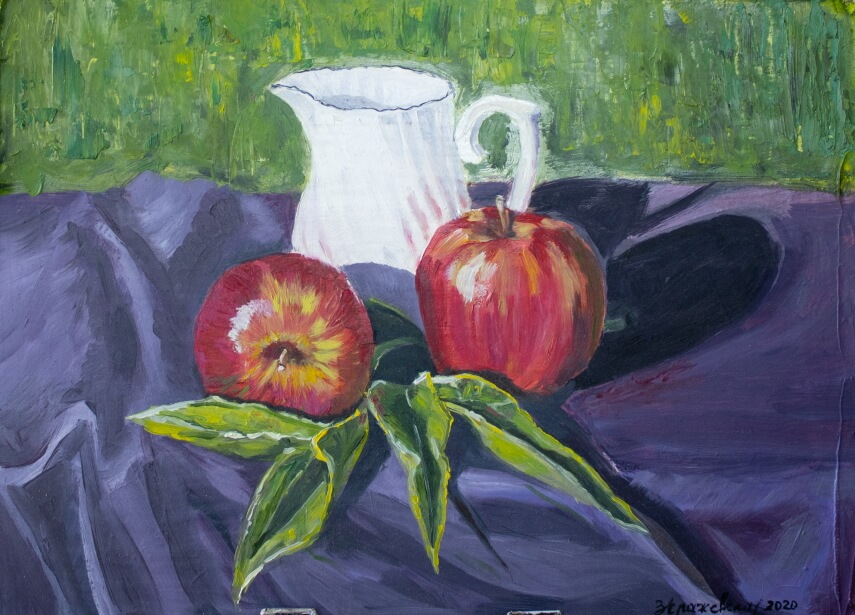Plein air Apples and pitcher
Plein air Apples and pitcher, like the phenomenon itself in fine art, is a fairly recent invention. Just two hundred years ago, artists began experimenting with drawing directly in nature, and until the beginning of the 19th century, all the great masters worked quietly in their workshops, and no one even thought of jumping through the forests and fields. In art, they began to look for and appreciate not an abstract mythological ideal, but living concrete. Later it was called impressionism. To see and capture life, and even more so the impression of it, elusive and fleeting, is possible only by examining nature — after all, the glare of moonlight, swaying grasses or a stormy sea cannot be transferred to your room. So the artists ended up on the street. Monet, Renoir, Pizarro depicted the same species many times, trying to catch light and color and get even a little closer to nature. We had Levitan, Korovin, Serov, Polenov in the open air. Handmade oil painting.
See other paintings by Evgenia Zragevskaya here: Lily on gray
Plein air: why languish in the sun, how to get ready and what to do with the audience. How many of you have not seen these strange people on wobbly chairs or with folding tables on long unstable legs? Fighting with the wind, scorching sun or rain, they try to do something on pieces of paper or pieces of cloth stretched over a wooden frame. Water spills, paints are smeared on the palette, mosquitoes eat them, passers-by point their fingers, and they … they are happy!
Before, I also wondered why they do this? Why create the most uncomfortable conditions for yourself when you can sit at home or in your cozy equipped workshop? What drives them out into the street, into the open air (this is how plein air is translated from French)?
Everything turned out to be very simple.
Pleasure.
Where did plein airs come from?
Claude Monet at the Edge of the Forest John Singer Sarget | Nadin Piter Nadin Piter Nadin Demkina’s blog Claude Monet at the edge of the forest. Painting by J.C. Sargent, 1895 (image author)
Plein air is a fairly recent invention. Just two hundred years ago, artists began experimenting with drawing directly in nature, and until the beginning of the 19th century, all the great masters worked quietly in their workshops, and no one even thought of jumping through the forests and fields.
First of all, it was technically difficult to do! Artist and illustrator Natalie Ratkowski in her LiveJournal tells in detail and fascinatingly how paint in tubes was invented and how it turned the art world upside down. In addition to the tubes, sketchbooks appeared, finally, the railway connection was established, which means that it was possible to quickly leave the city and return back.
For me, the landscape does not exist by itself, because its appearance changes every minute. But the surrounding atmosphere makes it alive — light and air, which are always different. For me, only the surrounding atmosphere gives the objects their true value.
But besides convenience, the worldview has changed. In art, they began to look for and appreciate not an abstract mythological ideal, but living concrete. Later it was called impressionism. To see and capture life, and even more so the impression of it, elusive and fleeting, is possible only by examining nature — after all, the glare of moonlight, swaying grasses or a stormy sea cannot be transferred to your room. So the artists ended up on the street. Monet, Renoir, Pizarro depicted the same species many times, trying to catch light and color and get even a little closer to nature. We had Levitan, Korovin, Serov, Polenov in the open air.
For those who are interested in more detail about this moment in the history of art, I recommend watching the BBC series «The Impressionists».
In addition to fun, of course, drawing in nature is a rewarding exercise. No wonder all students of art schools and universities in the summer are massively driven to practice. In our digital world, everything can be done with Google and photos. But even a hundred photos from the spot will not replace your nature!
In the photo, everything has already been decided for you.
And direct contact with the landscape gives a million ideas on how and what to draw. You can draw a huge panorama or take a small piece of it. You choose the angle, you notice the details, you choose the lighting. A casual passer-by can be a key element in the composition of a future painting. The bird that has flown is the main character.






